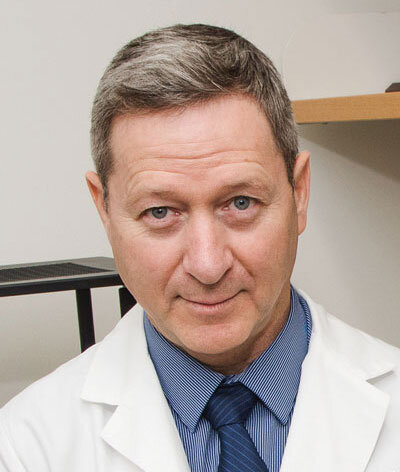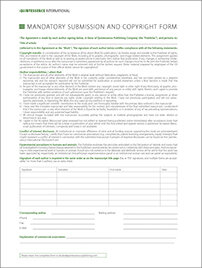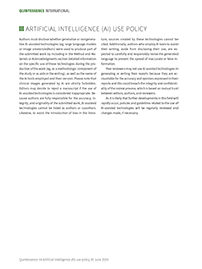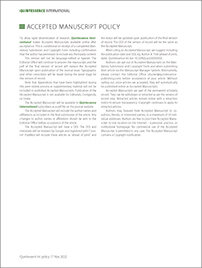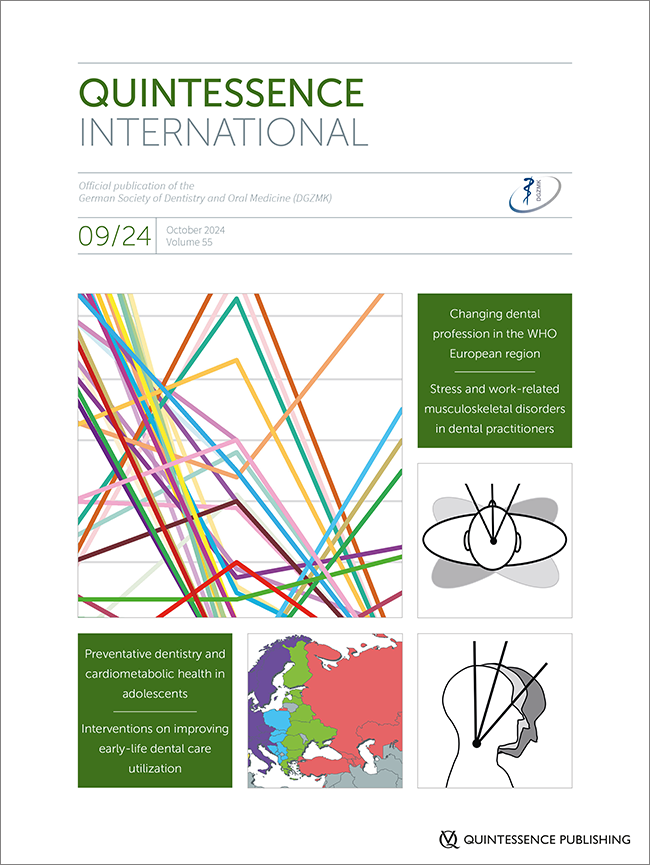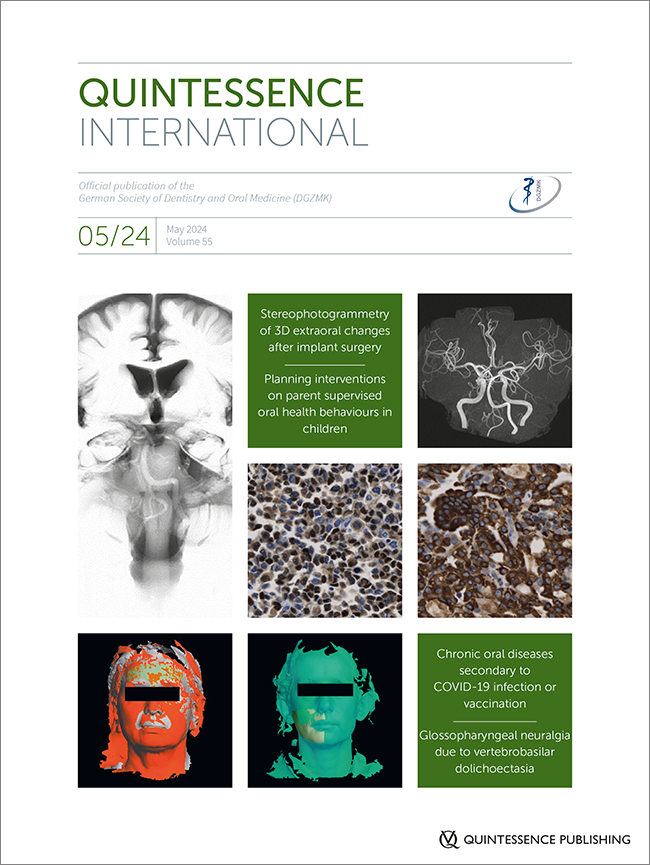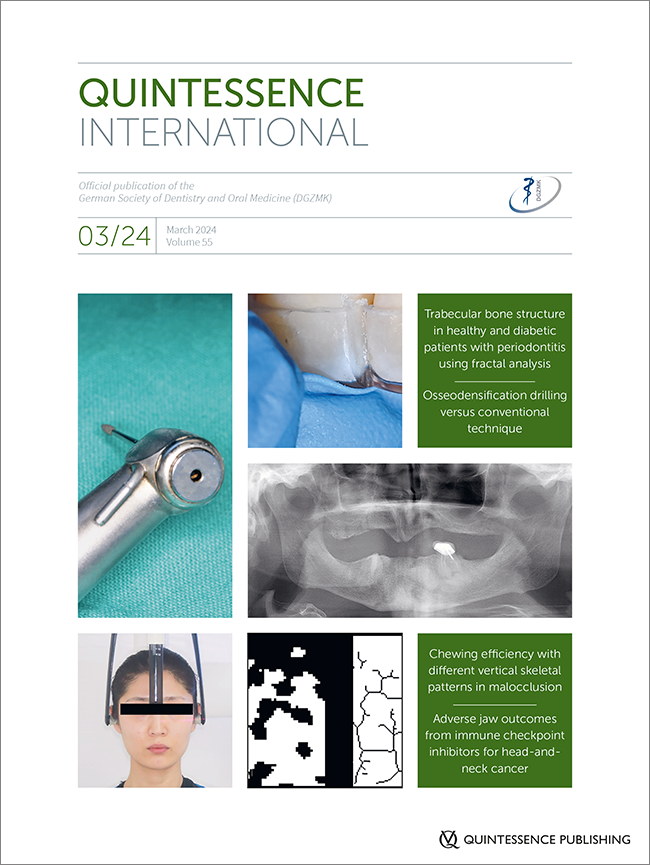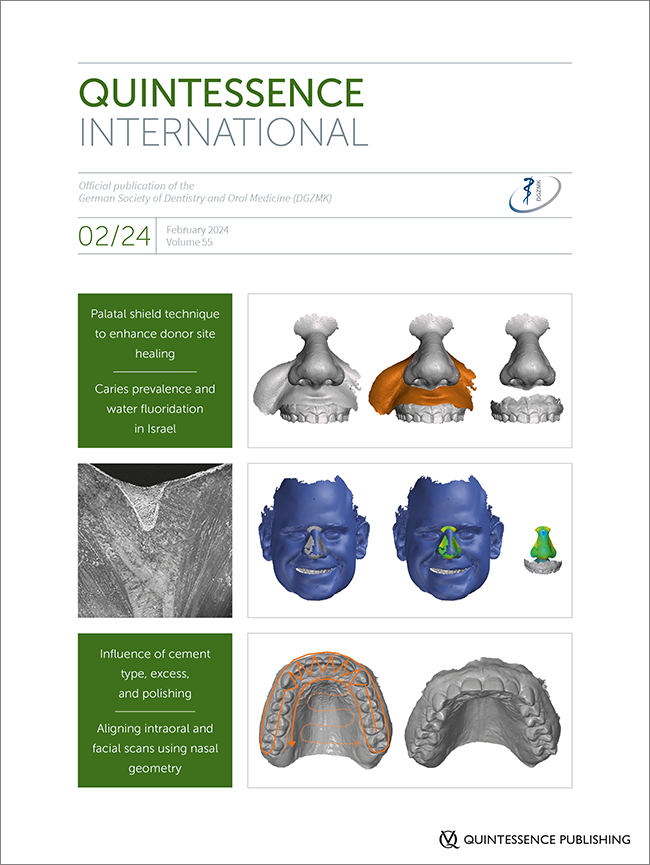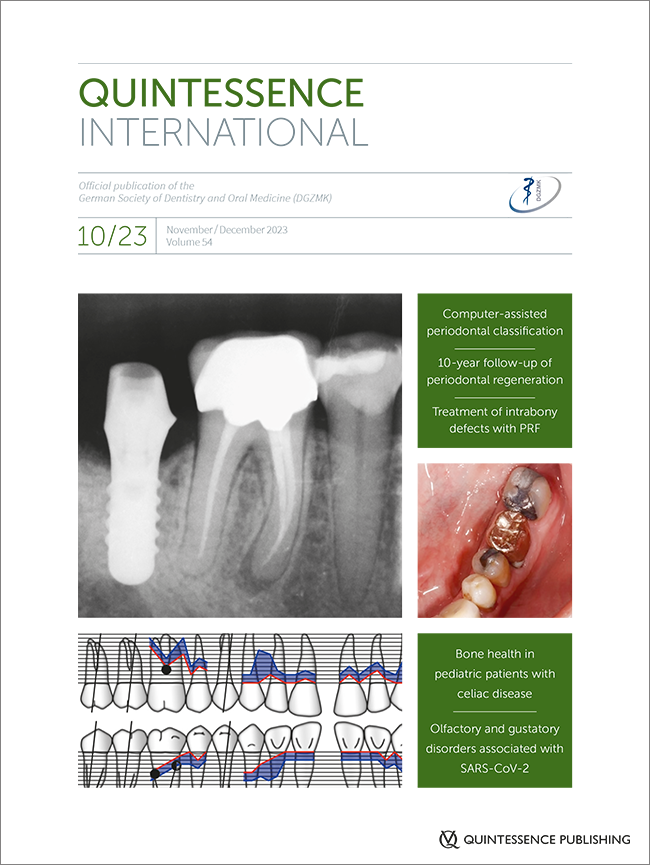DOI: 10.3290/j.qi.b5795701, PubMed-ID: 39444370Seiten: 684-685, Sprache: EnglischStephens, Nadejda Stefanova / Rasubala, LindaGuest EditorialDOI: 10.3290/j.qi.b5751220, PubMed-ID: 39287091Seiten: 686-691, Sprache: EnglischMcNeil, Rotem / Haviv, Yaron / Benoliel, Rafael / Sharav, YairTwo cases of pain evoked by cold food ingestion, following root canal therapy, are presented. The source of pain was detected when cold application to the vestibular, periapical area corresponding to the teeth involved evoked strong pain of about 30-second durations. In the first case, the patient suffered from strong pain in the mandibular right area over the last 4 months. After successive root canal therapy of three mandibular right teeth, the spontaneous pain eased significantly, but strong pain evoked by cold food ingestion persisted. Cold application to the vestibular periapical area of teeth involved identified the source of pain, which was abolished by 80 mg/day of slow-release propranolol. In the second case, cold allodynia developed after root canal therapy. The root canal therapy was performed for prosthetic reasons with no prior pain. Pain could be duplicated by cold application to the vestibular area of the treated tooth. The patient preferred no treatment when the source of pain was explained. In both cases cold application did not produce any pain in other intraoral locations, including the contralateral vestibular area or the mid soft or hard palate. Pain mechanisms, neurovascular and neuropathic, which differ for each case are discussed.
Schlagwörter: cold allodynia, ice-cream headache, neuropathic oral pain, neurovascular orofacial pain
DOI: 10.3290/j.qi.b5695436, PubMed-ID: 39162208Seiten: 692-702, Sprache: EnglischZheng, Wentian / Pang, Yongzhi / Gong, Hui / Shi, Min / Song, Ning / Guo, Tao / Jiang, YingyingObjectives: Diode laser represents a practical clinical strategy for treating gingival hyperpigmentation. However, its effectiveness remains controversial. The aim of this meta-analysis was to evaluate the quantitative effects of diode laser therapy on gingival hyperpigmentation. Method and materials: PubMed, Embase, Web of Science, and Cochrane Library were systematically searched for the use of diode laser in gingival hyperpigmentation. The primary outcomes assessed were the Dummett-Gupta Oral Pigmentation Index (DOPI), visual analog scale pain scores, and the Wound Healing Index (WHI) for overall evaluation. The I2 index was calculated to identify heterogeneity, and sensitivity analyses were performed to identify sources of heterogeneity. Funnel plots and the Egger test were utilized to evaluate publication bias. Results: Thirteen randomized controlled trials involving a total of 233 participants were included in the study. The analysis demonstrated that diode laser had a significant effect on DOPI (standard mean difference [SMD] = −0.245, 95% CI −0.451 to −0.040, P = .019) and pain (SMD = −0.809, 95% CI −1.332 to −0.285, P = .002), with no significant effect on WHI (SMD = −0.224, 95% CI −1.100 to 0.653, P = .617). Despite the significant heterogeneity in VAS and WHI indicated by the I2 index statistic, the sensitivity analyses’ results demonstrated the main findings’ reliability. While no significant publication bias was detected for DOPI and WHI, the pain results exhibited notable publication bias. Conclusion: The study demonstrated that diode laser prolongs gingival repigmentation time and reduces pain compared to other treatments. However, efficacy in wound healing was not significantly affected.
Schlagwörter: diode laser, gingival hyperpigmentation, meta-analysis
DOI: 10.3290/j.qi.b5566187, PubMed-ID: 38985439Seiten: 704-711, Sprache: EnglischBrandt, Silvia / Winter, Anna / Lauer, Hans-Christoph / Romanos, GeorgiosObjectives: To evaluate clasp-retained removable partial dentures (C-RPDs) with a metal framework for survival, maintenance requirements, and biologic implications. Method and materials: C-RPDs were retrospectively analyzed based on patient records. Treatment failure was defined as fracture of a framework component (metal base or connector) or loss of an abutment tooth. Other outcome variables included factors that might conceivably impact C-RPD survival (maxilla vs mandible, Kennedy classes, opposing dentitions, treatment by students vs certified dental practitioners), mobility and caries of abutment teeth (in relation to clasp designs), and maintenance requirements (relining, clasp or resin fractures). Differences were evaluated by appropriate statistical tests at the P ≤ .05 level. Results: A total of 612 patients (339 men, 273 women) 60.0 ± 11.5 years old at delivery were included, covering 842 C-RPDs and a mean observation period of 42.1 ± 33.2 months. Kaplan–Meier C-RPD survival was 76.2% after 5 years and 49.5% after 10 years. Biologic complications (ie, loss of abutment teeth) accounted for the vast majority (95.6%) of C-RPD failures, and Kaplan–Meier C-RPD survival was significantly better in the mandible (P = .015). Some clasp designs contributed significantly to caries and removal of abutment teeth (both P .05). No other significant differences were noted. Conclusion: Tooth loss both emerges as the main cause of C-RPD failure and might be amenable to careful selection of clasp designs. Overall, better C-RPD survival should be expected in the mandible. A noncontributory role of Kennedy classes and opposing dentitions is tentatively suggested based on numerically heterogenous subgroups.
Schlagwörter: clasp-retained removable partial dentures, dentures, maintenance requirements, prosthodontic treatment, secondary caries
DOI: 10.3290/j.qi.b5586051, PubMed-ID: 39016671Seiten: 714-721, Sprache: EnglischWong, Kristal / Nadella, Srighana / Mupparapu, Mel / Sethna, ChristineObjective: The aim of this study was to identify the relationship between preventative dental practices and cardiometabolic health in adolescents. Method and materials: Analysis included children aged 13 to 17 years enrolled in the National Health and Nutrition Examination Survey (NHANES) from 2011 to 2018 who completed an Oral Health Examination and Questionnaire. Deferred dental care was defined as not having a dental visit in the past year. Financial barriers to seeking dental care (vs no financial barriers) were assessed among those with deferred dental care in the past year. Primary cardiometabolic outcomes included obesity, elevated blood pressure, and hypertensive blood pressure. Secondary outcomes included dyslipidemia, glucose intolerance, uric acid, glomerular hyperfiltration, and albuminuria. Regression models adjusted for age, sex, race/ethnicity, household income, food insecurity, health insurance status, household education, and body mass index z-score examined associations using complex survey design procedures. Results: Of 2,861 adolescents, 17.6% (SE 0.9%) did not receive dental care in the past year and 20.2% (SE 1.9%) had a financial barrier to accessing dental care. In adjusted regression models, adolescents with deferred dental care had higher odds of dyslipidemia (odds ratio [OR]= 1.51, 95% CI 1.07 to 2.11, P = .020). Having a financial barrier was associated with lower odds of dyslipidemia (OR = 0.35, 95% CI 0.14 to 0.89, P = .03). Financial barriers were associated with lower non-high-density lipoprotein cholesterol (b = −7.95, 95% CI −14.87 to −1.05, P = .03) and higher high-density lipoprotein cholesterol (b = 3.06, 95% CI 0.37 to 5.75, P = .03) in adjusted models. Deferred dental care and financial barriers were not associated with any other cardiometabolic parameters. Conclusion: In this nationally representative cohort of adolescents, there was an association between lack of preventative dental care and the cardiometabolic health marker of dyslipidemia. However, financial barriers to dental care were surprisingly associated with higher high-density lipoprotein cholesterol levels and lower odds of dyslipidemia.
Schlagwörter: cardiometabolic, dyslipidemia, financial barriers, pediatric dental, pediatrics, preventative dental practices
DOI: 10.3290/j.qi.b5640008, PubMed-ID: 39078171Seiten: 722-732, Sprache: EnglischLy-Mapes, Oriana / Jang, Hoonji / Al Jallad, Nisreen / Rashwan, Noha / Castillo, Daniel A. / Lu, Xingyi / Fiscella, Kevin / Xiao, JinObjectives: Although early-life dental care is crucial for preventing early childhood caries and has numerous benefits, the utilization rate of such care remains remarkably low worldwide, especially in families of low socioeconomic status. The aim of this study was to systematically review the scientific evidence relating to the effectiveness of interventions on improving early-life dental care utilization of very young children. Method and materials: Scientific evidence relating to these positive changes was reviewed, with seven randomized controlled trials after qualitative evaluation. Interventions assessed included prenatal oral health promotion, motivational interviewing, intra-oral camera use alongside social work consultations to aid in decreasing barriers to care, monetary incentives for tooth brushing, fluoride varnish applications, and probiotic usage. Results: The intervention was significantly effective in reducing the incidence of dental caries among children, especially in caries risk. Caries reduction was significant when oral health information was provided at frequent intervals prenatally. Caries increment was also reduced when probiotics were introduced when administered daily. Interventions that attempted to increase parental involvement in oral health care by increasing motivation and decreasing barriers had inconclusive results within the study groups. Conclusions: Considering high rates of early childhood caries, early establishment and preservation of a dental home should be a focus in public health measures. Continuous monitoring and parental involvement are key components to maintaining healthy oral conditions. Future studies could explore and test various innovative strategies that utilize technological platforms to engage with parents and promote early-life dental care utilization among the underserved population.
Schlagwörter: caries, caries prevention, early childhood caries, early-life dental care, infants, randomized controlled clinical trial
DOI: 10.3290/j.qi.b5714863, PubMed-ID: 39190015Seiten: 734-742, Sprache: EnglischJia, ZhengYong / Chen, KeLiBackground: The pathogenesis of periodontitis may be related to host-mediated inflammatory and immune responses caused by accumulation of oral microbial plaque. Nutrients have anti-inflammatory and pro-inflammatory capabilities. Dietary intake of antioxidants and micronutrients is associated with the inflammatory burden of the diet. The Composite Dietary Antioxidant Index (CDAI) is a composite index for assessing the antioxidant properties of a diet, and the relationship with periodontitis is unclear. The aim of this study was to investigate the relationship between periodontitis and CDAI. Method and materials: The study was a cross-sectional design and included 7,471 participants from the National Health and Nutrition Examination Survey (NHANES) 2009 to 2014 database. Participants were divided into experimental and control groups according to the relevant criteria, where the control group consisted of participants with no/mild periodontitis (including 3,646 participants) and the experimental group consisted of participants with moderate/severe periodontitis (including 3,825 participants). First, baseline characteristics of the two groups of participants were compared. Weighted logistic regression analyses was used to explore the relationship between periodontitis and CDAI. The linear relationship between the two was assessed using restricted cubic spline. Finally, subgroup analyses were used to assess model stability. Results: Differences between the two groups of participants were statistically significant in age, sex, race, education, ratio of household income to poverty, body mass index, smoking status, drinking status, and prevalence of diabetes. CDAI, as a continuous variable, was not found to be significantly associated with periodontitis. The CDAI was converted to categorical variables according to quartile. In model 1, participants in the second and third quartile groups had a lower risk of developing periodontitis compared with participants in the lowest quartile group (OR [95% CI] 0.810 [0.681, 0.963], P = .021; OR [95% CI] 0.811 [0.691, 0.951], P = .014; respectively). In model 2, participants in the second, third, and fourth quartile groups had a lower risk of developing periodontitis compared to the lowest quartile group (OR [95% CI] 0.803 [0.660, 0.978], P = .0349; OR [95% CI] 0.753 [0.632, 0.897], P = .003; OR [95% CI] 0.753 [0.617, 0.920], P = .008; respectively). There was a non-linear relationship between CDAI and periodontitis (P non-linearity = .0055), with the inflection point occurring at a CDAI equal to 0.6342. Conclusion: There is a nonlinear relationship between CDAI and periodontitis in US adults. However, further prospective studies are still needed to validate the results.
Schlagwörter: Composite Dietary Antioxidant Index, periodontitis, risk factor
DOI: 10.3290/j.qi.b5714883, PubMed-ID: 39190016Seiten: 744-755, Sprache: EnglischWolf, Thomas Gerhard / Müller, Andrés Urs / Seeberger, Gerhard Konrad / Paulmann, Kerstin / Campus, Guglielmo / Deniaud, Jacques / Wagner, Ralf Friedrich / Zeyer, OliverObjectives: The study examines the impact of changes on dental education and practice in Europe, including the development of new practice models such as investor-owned dental centers and practice chains. Method and materials: This study aimed to collect and critically examine data regarding the care environment, education, and organizational structures of the dental profession across European Regional Organization of the FDI World Dental Federation (ERO) member states and other countries in the World Health Organization European region. A questionnaire from the ERO was used. Results: National dental associations across 45 countries participated. An average of 1,459.79 (SD ± 800.80) inhabitants per dental practitioner was found, with independent practices being the most prevalent form of dental practice (48.65% ± 28.28%) followed by employment in private practice (24.32% ± 20.33%), and joint practices (15.27% ± 20.39%). There are statistically significantly more state universities than private universities (P .01); the percentage of females attending dental schools was statistically significantly higher than males (P .01). Two-thirds of the participating countries (n = 30, 66.67%) have legal frameworks allowing various stakeholders, including investors, and local communities, to establish dental health care centers. Conclusions: The findings highlight the evolving landscape of the dental profession in Europe and its regulatory context. There is a clear need for ongoing evaluations and adjustments in educational and practice frameworks to ensure and maintain high-quality oral health care. Future research should delve into the various professional dental practice forms and incorporate qualitative, care-related, and patient-centered considerations for a more thorough understanding of Europe’s oral health care dynamics. (Quintessence Int 2024;55:744–755; doi: 10.3290/j.qi.b5714883)
Schlagwörter: dental health care center, dental service, Europe, form of dental practice, independent, liberal, questionnaire, young dental practitioners
DOI: 10.3290/j.qi.b5687916, PubMed-ID: 39150195Seiten: 756-765, Sprache: EnglischThies, Anke-Marei / Backhaus, Joy / Olmos, Manuel / Eitner, StephanObjectives: Prevalence of work-related musculoskeletal disorders (WRMSDs) among general dental practitioners and orthodontists is approximated to range between 64% and 93%. Etiology of WRMSDs in the mentally and physically demanding occupation remains unclear, for which reason the aim of the study was to clarify the interplay of physical, psychological, and mental factors on WRMSDs. Method and materials: Of 94 orthodontists and 187 general dental practitioners (mean age = 35 years) questioned using an online survey, 84% reported persisting tension or pain in the back, neck, or shoulders. While 71% of females were employed (29% self-employed), only 39% of male participants were employed. Cluster analysis was used to characterize dental practitioners according to their movement profile and the moderating effect of stress on certain WRMSDs. Results: Three movement profiles of general dental practitioners and orthodontists were significantly predictive of WRMSD. The minority could be characterized as healthy (n = 45), whereas twice as many reported nearly twice as much pain (n = 90). Stress proved to be a strong, significant moderator of WRMSDs in relation to sex, employment status, and body mass index. Conclusion: The prevalence of WRMSDs found was alarming. Given the feminization of dentistry, and that being female, stressed, and an employee (rather than self-employed) is a significant predictor of WRMSDs, this represents a danger to the German health system.
Schlagwörter: dental profession, employee, health, risk factors, stress, work-related musculoskeletal disorders



